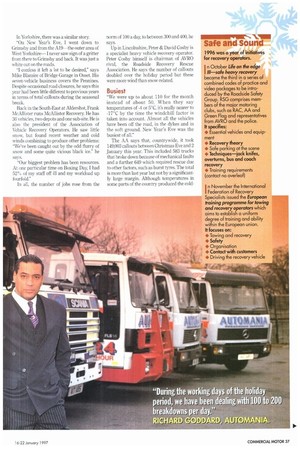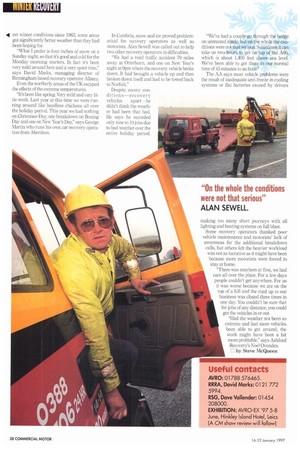COMFORT
Page 38

Page 39

Page 40

If you've noticed an error in this article please click here to report it so we can fix it.
It was a chilling end of year tale for some of the UK's recovery operators and a holiday season of mixed motoring fortunes in general for drivers. While the Siberian weather by-passed some of the more usual target areas at the extreme ends of the country, it hit the south-east of England the hardest for a change. There was even a snowflake on the Meteorological Office roof in London, on Christmas Day_ "From Central London along the airport corridor down the M4 has been very busy. This year the callout rate over the holiday period has gone up by over 100%," says Richard Goddard, director of Automania. Based at Heston Services near junction three on the M4 motorway, the company has three depots, with one at Hammersmith which deals with breakdowns of trucks, buses and cars in the central London area.
Extremely cold
"It has been extremely cold so that during the working days of the holiday period, we have been dealing with 100 to 200 breakdowns per day. On Christmas Day itself we handled about 30 and another 60 callouts came in on Boxing Day, which is a lot for those particular days," he adds.
According to some reports, the bad weather caught many local authorities by surprise, and some recovery operators felt this might have contributed to a rapid rise in callouts in some areas.
"At 9am on the Sunday after Christmas, we had a fax passed to us from the Met Office which gave severe weather warnings of a 70% chance of snow in East Anglia and Kent. By Monday morning we'd had rain which had turned to ice, followed by a thick layer of snow on top. Kent County Council hadn't gritted many of the roads," says Noel Ovenden, of Ashford Recovery which runs 12 vehicles. In Yorkshire, there was a similar story.
On New Year's Eve, I went down to Grimsby and from the A19—the outer area of West Yorkshire— I never saw sign of a gritter from there to Grimsby and back. It was just a white out on the roads.
"I confess it left a lot to be desired," says Mike Blamire of Bridge Garage in Osset. His seven-vehicle business covers the Pennines. Despite occasional road closures, he says this year had been little different to previous years in terms of total callouts during the seasonal break.
Back in the South-East at Aldershot, Frank McAllister runs McAllister Recovery. He has 36 vehicles, two depots and one sub-site. He is also the president of the Association of Vehicle Recovery Operators. He saw little snow, but found recent weather and cold winds combining to produce other problems: "We've been caught out by the odd flurry of snow and some quite vicious black ice." he says.
"Our biggest problem has been resources. At one particular time on Boxing Day, I had 52% of my staff off ill and my workload up fourfold."
In all, the number of jobs rose from the norm of 100 a day, to between 300 and 400, he says.
Up in Lincolnshire, Peter & David Cosby is a specialist heavy vehicle recovery operator. Peter Cosby himself is chairman of AVRO rival, the Roadside Recovery Rescue Association. He says the number of callouts doubled over the holiday period but these were more wind than snow-related.
Busiest "We were up to about 110 for the month instead of about 50. When they say temperatures of -4 or 5°C, it's really nearer to -17°C by the time the windchill factor is taken into account. Almost all the vehicles have been off the road, in the dykes and in the soft ground. New Year's Eve was the busiest of all."
The AA says that, countrywide, it took 149,003 callouts between Christmas Eve and 2 January this year. This included 583 trucks that broke down because of mechanical faults and a further 649 which required rescue due to other factors, such as burst tyres. The total is more than last year but not by a significantly large margin. Although temperatures in some parts of the country produced the cold
.4 est winter conditions since 1963, some areas got significantly better weather than they had been hoping for.
"What I prefer is four inches of snow on a Sunday night, so that it's good and cold for the Monday morning starters. In fact it's been very mild around here and a very quiet time," says David Marks, managing director of Birmingham-based recovery operator Albany Even the northerly areas of the UK escaped the effects of the extreme temperatures.
"It's been like spring. Very mild and very little work. Last year at this time we were running around like headless chickens all over the holiday period. This year we had nothing on Christmas Day, one breakdown on Boxing Day and one on New Year's Day" says George Martin who runs his own car recovery operation from Aberdeen. In Cumbria, snow and ice proved problematical for recovery operators as well as motorists. Alan Sewell was called out to help two other recovery operators in difficulties.
"We had a road traffic accident 70 miles away at Otterburn, and one on New Year's night at 9pm where the recovery vehicle broke down. It had brought a vehicle up and then broken down itself and had to be towed back to Norfolk."
Despite snowy conditions—recovery vehicles apart—he didn't think the weather had been that bad. He says he recorded only nine to 10 jobs due to bad weather over the entire holiday period. "We've had a couple go through the hedge on untreated roads, but on the whole the conditions were not that serious. Sometimes it can take us two hours to get on top of the A66, which is about 1,400 feet above sea level. We've been able to get there in our normal time of 45 minutes loan hour."
The AA says most vehicle problems were the result of inadequate anti-freeze in cooling systems or flat batteries caused by drivers making too many short journeys with all lighting and heating systems on full blast. Some recovery operators thanked poor vehicle maintenance and motorists' lack of awareness for the additional breakdown calls, but others felt the heavier workload was not as lucrative as it might have been because more motorists were forced to stay at home.
"There was mayhem at first, we had cars all over the place. For a few days people couldn't get anywhere. For us it was worse because we are on the top of a hill and the road up to our business was closed three times in one day. You couldn't be sure that for jobs of any distance, you could get the vehicles in or out.
"Had the weather not been so extreme and had more vehicles been able to get around, the work might have been a bit more profitable," says Ashford Recovery's Noel Ovenden. by Steve McQueen












































































































